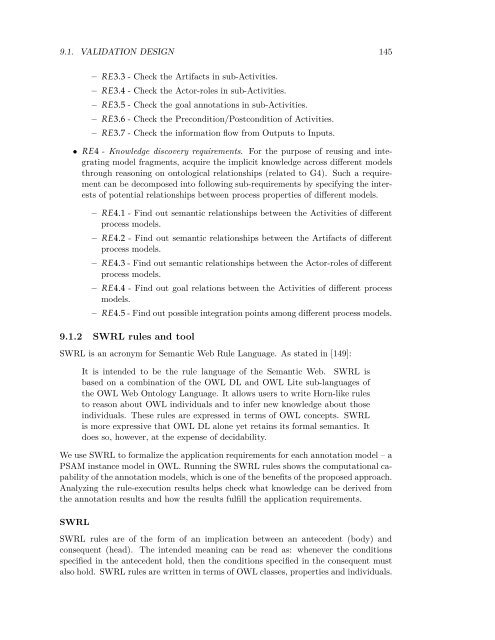Semantic Annotation for Process Models: - Department of Computer ...
Semantic Annotation for Process Models: - Department of Computer ...
Semantic Annotation for Process Models: - Department of Computer ...
Create successful ePaper yourself
Turn your PDF publications into a flip-book with our unique Google optimized e-Paper software.
9.1. VALIDATION DESIGN 145<br />
– RE3.3 - Check the Artifacts in sub-Activities.<br />
– RE3.4 - Check the Actor-roles in sub-Activities.<br />
– RE3.5 - Check the goal annotations in sub-Activities.<br />
– RE3.6 - Check the Precondition/Postcondition <strong>of</strong> Activities.<br />
– RE3.7 - Check the in<strong>for</strong>mation flow from Outputs to Inputs.<br />
• RE4 - Knowledge discovery requirements. For the purpose <strong>of</strong> reusing and integrating<br />
model fragments, acquire the implicit knowledge across different models<br />
through reasoning on ontological relationships (related to G4). Such a requirement<br />
can be decomposed into following sub-requirements by specifying the interests<br />
<strong>of</strong> potential relationships between process properties <strong>of</strong> different models.<br />
– RE4.1 - Find out semantic relationships between the Activities <strong>of</strong> different<br />
process models.<br />
– RE4.2 - Find out semantic relationships between the Artifacts <strong>of</strong> different<br />
process models.<br />
– RE4.3 - Find out semantic relationships between the Actor-roles <strong>of</strong> different<br />
process models.<br />
– RE4.4 - Find out goal relations between the Activities <strong>of</strong> different process<br />
models.<br />
– RE4.5 - Find out possible integration points among different process models.<br />
9.1.2 SWRL rules and tool<br />
SWRL is an acronym <strong>for</strong> <strong>Semantic</strong> Web Rule Language. As stated in [149]:<br />
It is intended to be the rule language <strong>of</strong> the <strong>Semantic</strong> Web. SWRL is<br />
based on a combination <strong>of</strong> the OWL DL and OWL Lite sub-languages <strong>of</strong><br />
the OWL Web Ontology Language. It allows users to write Horn-like rules<br />
to reason about OWL individuals and to infer new knowledge about those<br />
individuals. These rules are expressed in terms <strong>of</strong> OWL concepts. SWRL<br />
is more expressive that OWL DL alone yet retains its <strong>for</strong>mal semantics. It<br />
does so, however, at the expense <strong>of</strong> decidability.<br />
We use SWRL to <strong>for</strong>malize the application requirements <strong>for</strong> each annotation model – a<br />
PSAM instance model in OWL. Running the SWRL rules shows the computational capability<br />
<strong>of</strong> the annotation models, which is one <strong>of</strong> the benefits <strong>of</strong> the proposed approach.<br />
Analyzing the rule-execution results helps check what knowledge can be derived from<br />
the annotation results and how the results fulfill the application requirements.<br />
SWRL<br />
SWRL rules are <strong>of</strong> the <strong>for</strong>m <strong>of</strong> an implication between an antecedent (body) and<br />
consequent (head). The intended meaning can be read as: whenever the conditions<br />
specified in the antecedent hold, then the conditions specified in the consequent must<br />
also hold. SWRL rules are written in terms <strong>of</strong> OWL classes, properties and individuals.
















